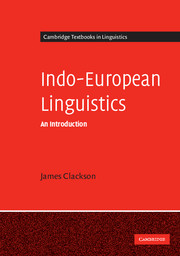Book contents
- Frontmatter
- Contents
- List of figures
- List of tables
- Preface
- Transliteration conventions
- 1 The Indo-European language family
- 2 Phonology
- 3 Morphophonology
- 4 Nominal morphology
- 5 Verbal morphology
- 6 Syntax
- 7 Lexicon and lexical semantics
- Glossary
- References
- Word index
- Language index
- Person index
- Subject index
Preface
Published online by Cambridge University Press: 05 June 2012
- Frontmatter
- Contents
- List of figures
- List of tables
- Preface
- Transliteration conventions
- 1 The Indo-European language family
- 2 Phonology
- 3 Morphophonology
- 4 Nominal morphology
- 5 Verbal morphology
- 6 Syntax
- 7 Lexicon and lexical semantics
- Glossary
- References
- Word index
- Language index
- Person index
- Subject index
Summary
Do we need another introduction to Indo-European linguistics? Since 1995 four have been published in English (Beekes 1995, Szemerényi 1996, Meier-Brügger 2003, Fortson 2004) and the ground seems to be pretty well covered. This book, however, aims to be an introduction of a different sort. Whereas the works mentioned give up-to-date and (usually) reliable information on the current thinking on what is known in Indo-European studies, here the aim is to present rather areas where there currently is, or ought to be, debate and uncertainty. Whereas previous introductions have aimed for the status of handbooks, reliable guides to the terrain presented in detail, this one aspires more to the status of a toolkit, offering up sample problems and suggesting ways of solving them. The reader who wants to know the details of how labio-velar consonants developed in Indo-European languages or the basis for the reconstruction of the locative plural case ending will not find them here; instead they will be able to review in detail arguments about the categories of the Indo-European verb or the syntax of relative clauses. The result is that this book has shorter chapters on areas such as phonology, where there is now more general agreement in the field, and correspondingly longer sections on areas which are passed by more summarily in other introductions. Memory athletes may be disappointed by the reduction in data, but I hope that others will welcome the increase in argumentation.
- Type
- Chapter
- Information
- Indo-European LinguisticsAn Introduction, pp. xii - xiiiPublisher: Cambridge University PressPrint publication year: 2007
- 1
- Cited by

